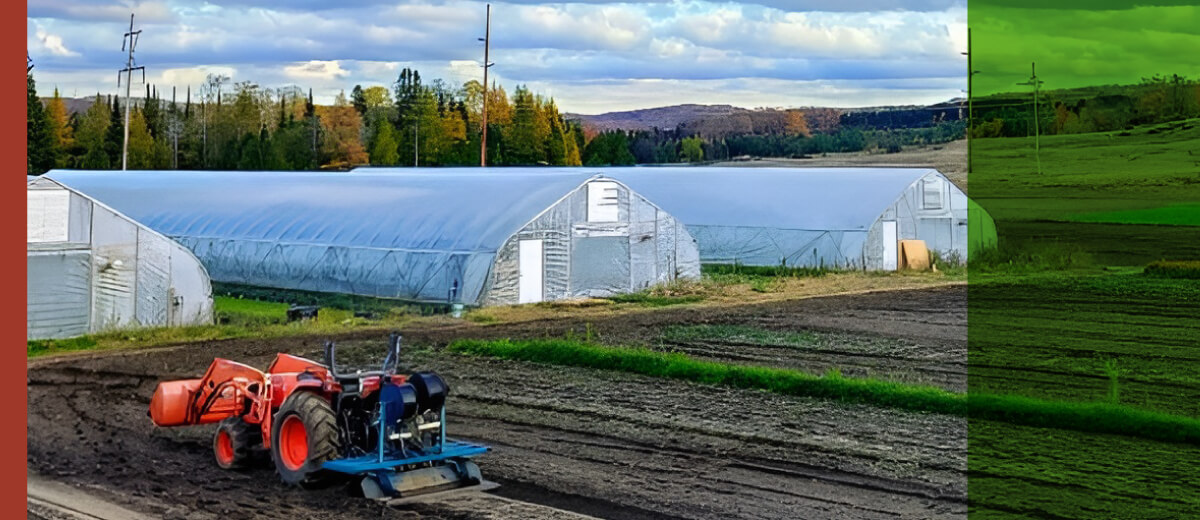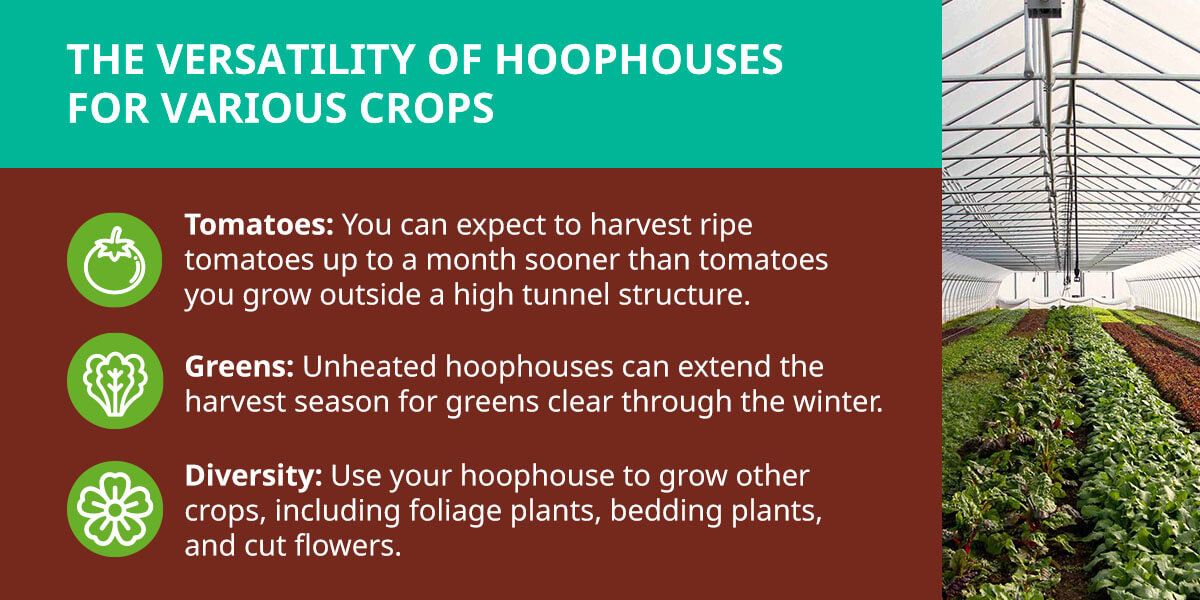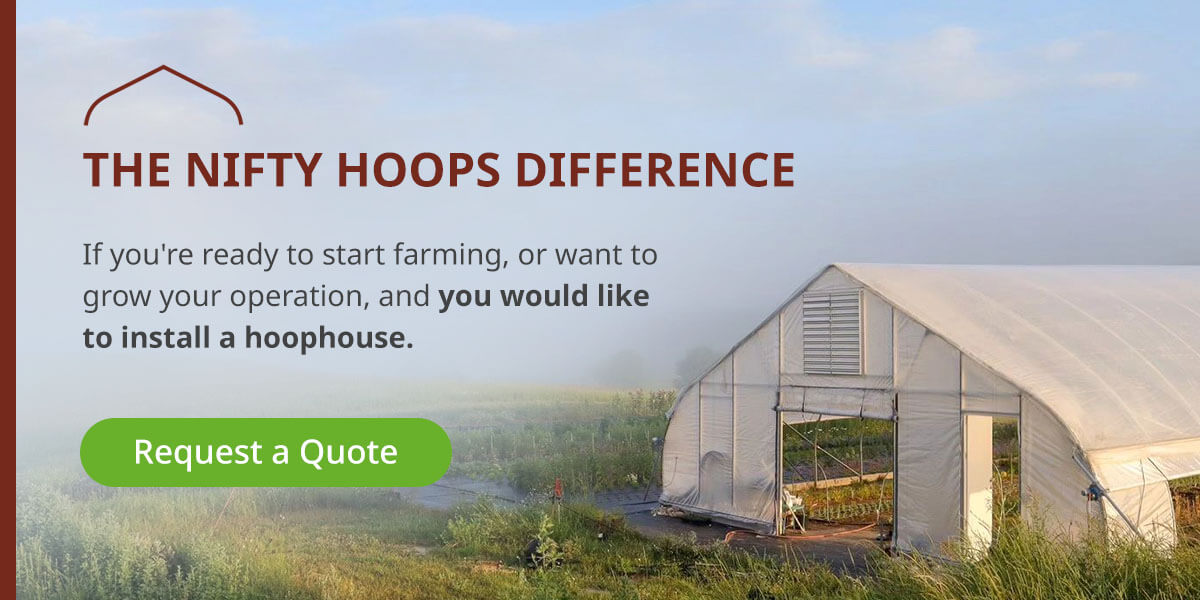
Why a Hoop House Is Right for You
Hoop houses, also called high tunnels, make an excellent addition to any farm. These structures support diverse crop growth, higher crop quality, increased yields, and longer growing seasons. Compared to conventional greenhouses, hoop houses offer a better return on investment (ROI) and use simple systems for environmental control.
Reap the benefits of hoop houses with Nifty Hoops. Our selection of high tunnel structures and installation support options makes year-round farming accessible to your farm and community. Request a quote today and learn more about why a hoop house is right for you.
The Impact of Hoop Houses on Crop Yield and Quality
Hoop houses impact crop yield and quality in these key ways:
- Protection:High tunnels protect crops from the elements. Keep your plants safe from extreme cold, heavy rain, and strong winds by using a hoop house.
- Crop quality: Hoop houses help improve the quality of your crops by protecting them from frostbite, wind, and other environmental stressors. Plus, they keep yields safer from insects and fungal pathogens that wish to eat your crops.
- Extended growing season: The primary benefit of growing your crops inside a hoop house is extending your harvest and producing a higher crop yield than field production.
What Grows Well in a Hoop house?
Hoop houses primarily rely on methods like direct sunlight for heating and rolling up the sides and opening vents for cooling. The natural environment inside a hoop house is ideal for growing a variety of crops you already have on your farm. Hoop houses are especially good for growing an assortment of vegetables that contribute to local food systems, even during cold northern winters.
Hoop houses are often compared to conventional greenhouses, but the two provide different growing environments. The sun is the primary heat source for both hoop houses and greenhouses, but greenhouses generally tend to utilize concrete floors, solid walls, and more intensive environmental controls to manage climate for nursery or bedding plant production. Both spaces can accommodate electric or gas heat sources for heating, as well as vents and fans for controlled cooling. Both structures can accommodate plant propagation and nursery production, although Hoop houses are best suited for in-ground crop production. Hoop houses also tend to cost a significant amount less per square foot for both building materials and installation.
The Versatility of Hoop Houses for Various Crops
- Protection: High tunnels protect crops from the elements. Keep your plants safe from extreme cold, heavy rain, and strong winds by using a hoop house.
- Crop quality: Hoop houses help improve the quality of your crops by protecting them from frostbite, wind, and other environmental stressors. Plus, they keep yields safer from insects and fungal pathogens that wish to eat your crops.
- Extended growing season: The primary benefit of growing your crops inside a hoop house is extending your harvest and producing a higher crop yield than field production.

Hoop Houses are highly versatile structures. Grow warm-weather crops like tomatoes and cool-weather crops like leafy greens in your hoop house. You can grow anything from spinach, carrots, and beets to turnips, scallions, and radishes in your high tunnel structure and see unique benefits for crops:
- Tomatoes: When you grow tomatoes in a hoop house, you can expect to harvest ripe tomatoes up to a month sooner than tomatoes you grow outside a high tunnel structure. You'll have the first tomatoes of the season and extend your growing season by over a month!
- Greens: Unheated hoop houses can extend the harvest season for greens clear through the winter. In the summer months, hoop houses with shade cloths can enhance the growth of leafy greens by reducing the severity of bolting (producing flowering stems and setting seeds too early before harvest).
- Diversity: Growing food in your hoop house is a rewarding and vital part of sustainable agriculture, but hoop houses are capable of more. Use your hoop house to grow other crops, including foliage plants, bedding plants, and cut flowers.
Making Profit Through an Extended Growing Season
Food is always a necessity and a valuable global resource. With an increase in food demand, farming has become an even more significant investment.
Farming as an Investment: The Hoop House Perspective
Farming with a hoop house leads to excellent ROI. Here's how:
- Grow crops faster and longer than if you grew them outside, increasing crop volume and associated sales.
- Experience a higher ROI compared to a greenhouse since up front costs of materials, installation, environmental controls are lower. Hoop houses allow you to grow crops in the ground as you normally would, and you can modify the growing conditions by rolling up the sides for cooling. In a greenhouse, plants are not usually grown in the ground. Greenhouses can get very hot very quickly — even with open doors and windows — so you must invest more in environmental controls to support plant growth.
- Grow crops year-round and produce out-of-season fruits and vegetables that buyers would be willing to pay more for.
- The conditions in a hoop house promote a higher-quality yield that consumers may buy at premium prices.
- Strengthen your brand as you become a reliable farm that meets food demand with quality produce year-round.
Benefits of Hoop Houses for Farms and Communities
The most significant benefit of hoop houses for communities is promoting sustainable farming practices that support local food production. They also benefit farms and communities in the following ways:
- High tunnels, like Nifty Hoops systems, are easy to install — you can complete the setup on your own without needing a professional team.
- Individuals and communities can save on the cost of food by purchasing from local farms that can meet their supply needs in and out of season. Money invested in local food stays within the community, leading to stronger community economies
FAQs About Hoop Houses
Here are some of the most common questions we get asked about hoop houses:
Are There Different Sizes of Hoop Houses Available?
Yes. Nifty Hoops offers different sizes of hoop houses for all preferences — no matter the size of the farm or growing area you have. We offer 30', 22.5', and 16'-wide Gothic Hoop Houses, in lengths from 16' to 192' long. We manufacture our hoop houses using the highest-quality American materials, and you can customize them with accessories to further match your needs.
How Quickly Can I Install a Hoop House?
Installation time varies based on the installation type you choose and the size of your team. We encourage growers to install their hoop houses themselves because our high tunnels feature a straightforward design. We have a range of video instructions to support DIYers, and our team is available over the phone seven days a week.
If your team is small and needs extra help, we offer three other installation options:
- Starter build: One of our builders sets the posts and builds the first section alongside you, training you along the way on how to finish the job. This option is great for your first hoop house and opens the door for a DIY build for your next one.
- Community build: Two Nifty Hoops builders will assist your team with the entire installation. As with the starter build selection, your team gains helpful insight during the installation process so they can handle ongoing maintenance, and will be ready for a DIY installation for subsequent hoop houses.
- Full install: If your team doesn't have the capacity to install your hoop house, our professionals can complete a full installation for you.
How Long Will My Hoop House Last?
A quality hoop House that you maintain well can last for a lifetime, but keep in mind that different components — from the frame to the plastic film — all have varying service lives.
The Nifty Hoops Difference
Using a hoop House is undoubtedly beneficial for farms and local food systems. As a farmer, you can protect your crops, increase your yield, improve plant quality, and boost profits. At Nifty Hoops, we help small and midsize farms thrive. We believe in localizing food systems and providing the resources farmers need, which is why we offer quality hoop houses and accessories to meet each farm's unique needs.
If you're ready to start farming, or want to grow your operation, and you would like to install a hoop house to launch your initiative, our professional team is ready to help. Feel free to contact us with any questions, request a quote, or browse our hoop houses today!








